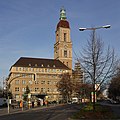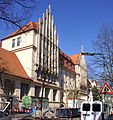Hans Altmann (architect)

Hans Altmann (born December 11, 1871 in Danzig ; † January 27, 1965 in West Berlin ) was a German architect .
life and work
Altmann studied architecture in Berlin and was appointed to the Friedenau councilor in 1904. After he had created the Royal Ministry of State in 1899/1900, he was regarded in the architectural world as a “creative and versatile artistic spirit”. Typical of his picturesquely grouped buildings are a quality that characterizes the townscape and an independent architectural signature that moves between historicism , art nouveau and modernism . Outstanding here is the Friedenau town hall with the characteristic tower placed on the corner, which was built between 1913 and 1917, and just three years later with the formation of Greater Berlin in 1920 and the accompanying incorporation of Friedenau into the former Schöneberg district had lost its function again. Altmann immortalized himself with a portrait bust at the Friedenau town hall as early as 1917.
Altmann's buildings still shape the image of the former country house colony in Friedenau: Rheingau grammar school , Paul Natorp high school , the Protestant parish and parish house on Friedrich-Wilhelm-Platz , a kiosk on Liane-Berkowitz-Platz as well as the Bobertal high school and the Ruppin primary school in Offenbacher Strasse are works that still shape the cityscape today.
At that time, the Schöneberg III cemetery was built , and today the graves of Marlene Dietrich , Helmut Newton and Ferruccio Busoni are also located here. When this space became scarce, the then still independent municipality of the former Teltow district decided to purchase around twelve hectares for another burial area in Gütergotz (renamed Güterfelde in 1937 ) - immediately adjacent to the Stahnsdorf south-west cemetery . Altmann was assigned the planning for the site. The burial site was opened in 1914 as the Friedenau forest cemetery in Gütergotz and is now called the Güterfelde Wilmersdorfer Forest Cemetery . With its semicircular curved paths, the complex is reminiscent of the Friedenau town plan. Altmann had a large chapel with a clinker brick facade built for the center of the cemetery . In the cemetery is the urn grave of the actor Max Schreck , made famous by his portrayal of Count Orlok in Murnau's film Nosferatu .
Hans Altmann died in Berlin in 1965 at the age of 93 and was buried in the Dahlem forest cemetery. The grave has not been preserved.
Chapel at the Schöneberg III cemetery
Kiosk on
Liane-Berkowitz-Platz
literature
- Peter Hahn, Jürgen Stich: Friedenau - history & stories. Oase Verlag 2015. ISBN 978-3-88922-107-0 .
- Peter Hahn: Berlin cemeteries in Stahnsdorf. Oase Verlag 2010. ISBN 978-3-88922-065-3 .
Web links
- Peter Hahn, Jürgen Stich: Website with detailed documentation on Hans Altmann.
Individual evidence
- ^ Hans-Jürgen Mende: Lexicon of Berlin burial places . Pharus-Plan, Berlin 2018, ISBN 978-3-86514-206-1 , p. 577.
| personal data | |
|---|---|
| SURNAME | Altmann, Hans |
| BRIEF DESCRIPTION | German architect |
| DATE OF BIRTH | December 11, 1871 |
| PLACE OF BIRTH | Danzig |
| DATE OF DEATH | January 27, 1965 |
| Place of death | Berlin |




